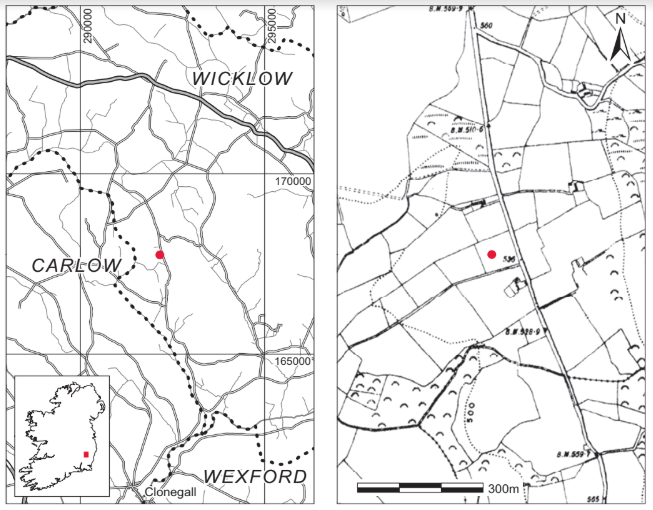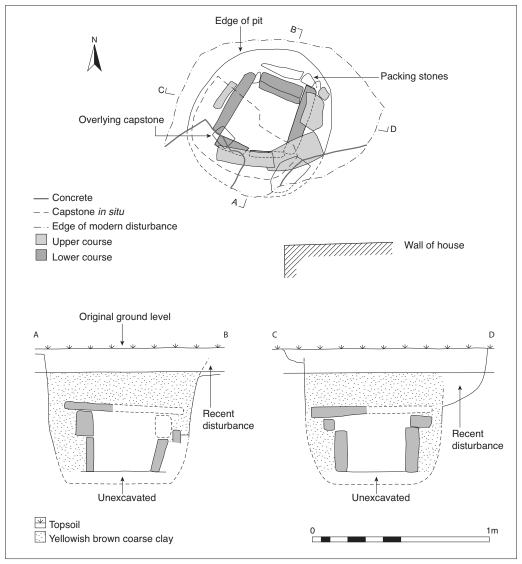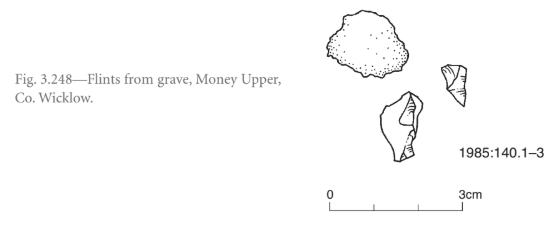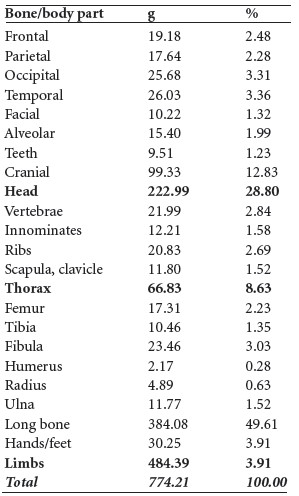County: Wicklow Site name: MONEY UPPER, CO. WICKLOW
Sites and Monuments Record No.: SMR WI042-044 Licence number: E1195
Author: EAMONN P. KELL
Site type: Early Bronze Age graves
Period/Dating: —
ITM: E 692093m, N 667799m
Latitude, Longitude (decimal degrees): 52.753402, -6.635760
Introduction
In December 1984 a short cist containing cremated bone was discovered in the garden of a dwelling house near Shillelagh, Co. Wicklow, when it flooded. Assuming that there was a leak in a pipe, a neighbour of the landowner dug around the area to investigate. The capstone was broken in the process and the fill was removed. The site was not reported to the Museum until March of the following year, as the finders were not sure whether the bone was animal or human. A rescue excavation was undertaken by Eamonn P. Kelly and the human remains were examined by Barra Ó Donnabháin.
Location (Fig. 3.246)
The site was in the townland of Money Upper, south-west Co. Wicklow, just 600m east of the border with County Carlow.378 It lay in a valley between two low hills at an altitude of 130–140m above sea level. No other cist sites are listed in the SMR for the area but many early Bronze Age burials are known from a cemetery mound, and possibly one or more flat cemeteries, uncovered in the nineteenth century at Ballon Hill (Waddell 1990, 51–2), 8km to the south-west.
Description of site
The cist was subrectangular in plan, with its long axis aligned north-east/south-west. It measured 0.35m long by 0.32m wide by 0.35m high internally (Fig. 3.247).

The walls were built in two courses. The lower course consisted of five stones set on end (one each at the western and eastern sides and two each at the northern and southern ends) and the upper course consisted of stones that had been laid flat and supported the capstone directly. The upper course had been removed at the northern side. Packing stones were visible, particularly outside the northern end of the cist. The floor of the cist was paved with a single flat slab. Half of the capstone had been removed by the finder. It was partly overlain by concrete from the house foundation, which prevented the dismantling of the grave to excavate the pit. It was possible to ascertain that the pit was approximately circular in shape, measuring 0.77m wide by c. 0.64m deep. The top of the pit lay 0.14m below ground level.
The cist contained a cremation of a young adult male (1985:14) and three chert flakes. As noted above, the contents had been removed by the finders and were thus quite disturbed. The cist fill consisted of yellow-brown coarse clay. A piece of carbonised wood was also found in the cist.
Lithics
Three unworked flint fragments were found in the cremation deposit.
Unworked burnt flint fragment 1985:140.1: This is an unstruck fragment with cortex present on one surface. Dimensions: max. L 1.8cm.
Chert flake 1985: 140.2: Unworked burnt flint flake fragment. Dimensions: max. L 1.7cm.
Chert flake 1985:140.3: Unworked burnt flint flake, probably débitage.
Dimensions: max. L 0.95cm.


Comment
The human remains from this site have not been dated. No pottery was retrieved and the chert flakes are not sufficiently diagnostic to provide any dating evidence, but most cists of this type date from the early Bronze Age.
HUMAN REMAINS
BARRA Ó DONNABHÁIN
Introduction
A relatively large collection—1,362.78g—of burnt bone (1985:14) was recovered from the cist. The remains are those of a younger adult male. The average fragment size in the deposit is 10–15mm, though the largest piece of bone encountered has a maximum length of 84.05mm. All body parts are represented in the remains. Table 3.171 lists all the major bones/body parts identified, along with the weights of these fragments and the percentage they represent of the identified total. All of the remains are calcined and have the warping and cracking that is characteristic of a fleshed body burnt at high temperatures over a considerable time. While most of the fragments are a calcined-white colour, some are of a blue-green lime that is reminiscent of copper staining. Shipman et al. (1984) have reported that such colour changes can be due to the temperatures reached in the pyre.
No charcoal, animal remains or clinker (the remains of burnt flesh and hair) were found with this individual.
Age and sex
The rugose nature of the supraorbital ridges and the nuchal crest of the skull indicate that this was a male.
The only age-diagnostic features available for inspection were the endocranial sutures. These are open and convoluted, suggesting that this individual was a younger adult, though it must be remembered that there is considerable variability in the timing of closure of the sutures.
Teeth
The presence of unhealed tooth sockets indicates that the following teeth were present at the time of death:

Conclusions
The deposit recovered from the cist contains the remains of one individual—a younger adult male. No anomalies or pathological conditions were noted in the remains, though it must be remembered that the cremation process often destroys evidence of such conditions. The corpse was efficiently cremated, as all areas of the body were completely incinerated. This implies that the pyre was maintained at high temperatures for a number of hours. The post-cremation retrieval of remains was meticulous. All body parts are represented in the deposit (see Table 3.171) and many of the smaller skeletal elements—e.g. bones of the hands and feet, a patella— were recovered. The preponderance of long bone fragments suggests a slight collection bias in their favour. This may simply be due to the fact that portions of long bones are the largest fragments remaining after a body has been burnt and are, as a result, easier to collect from among the remains of the pyre. The average fragment size is small. This might suggest that the remains were crushed after retrieval.
Table 3.171—Weights and percentages of identified bone fragments, 1985:14.

378. Parish of Aghowle, barony of Shillelagh. SMR WI042-044——. IGR 292163 167759.